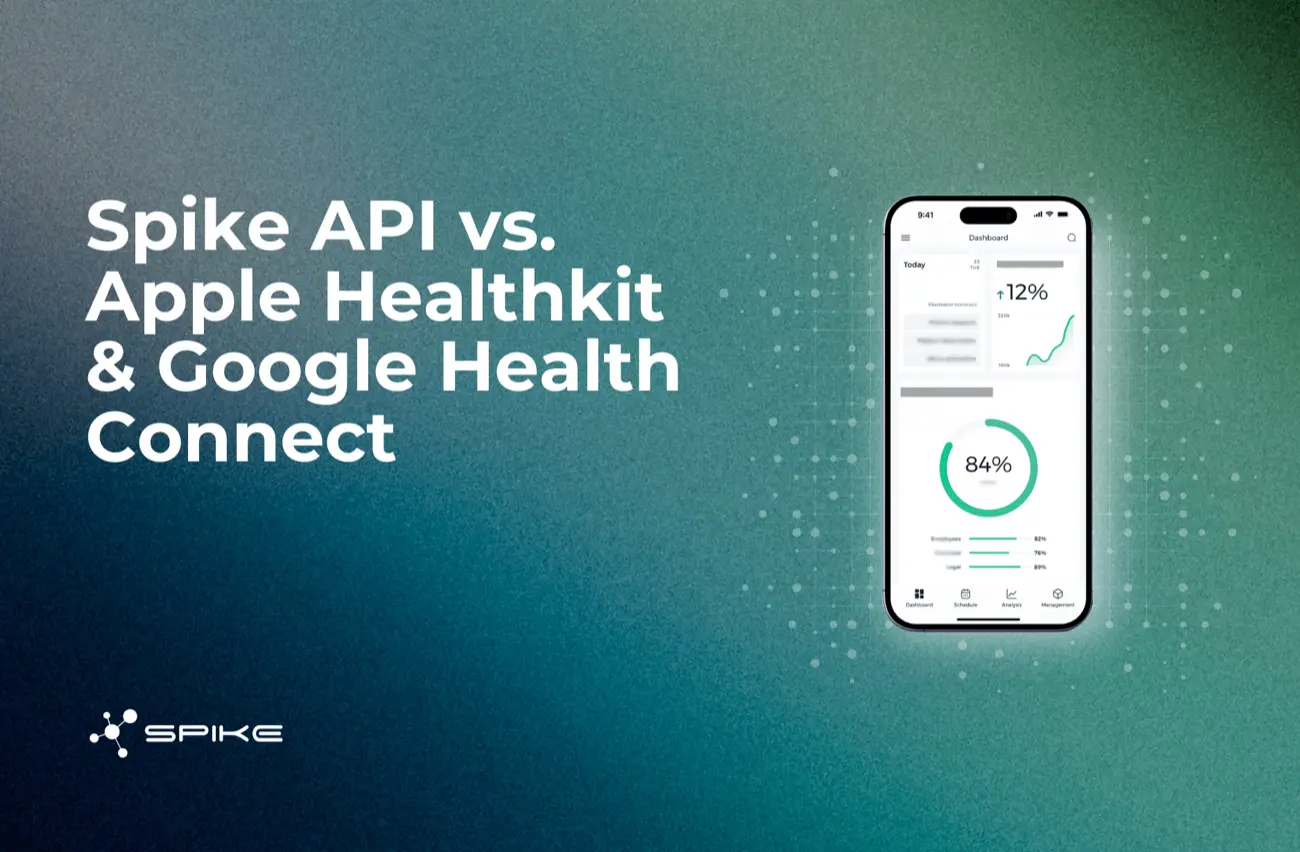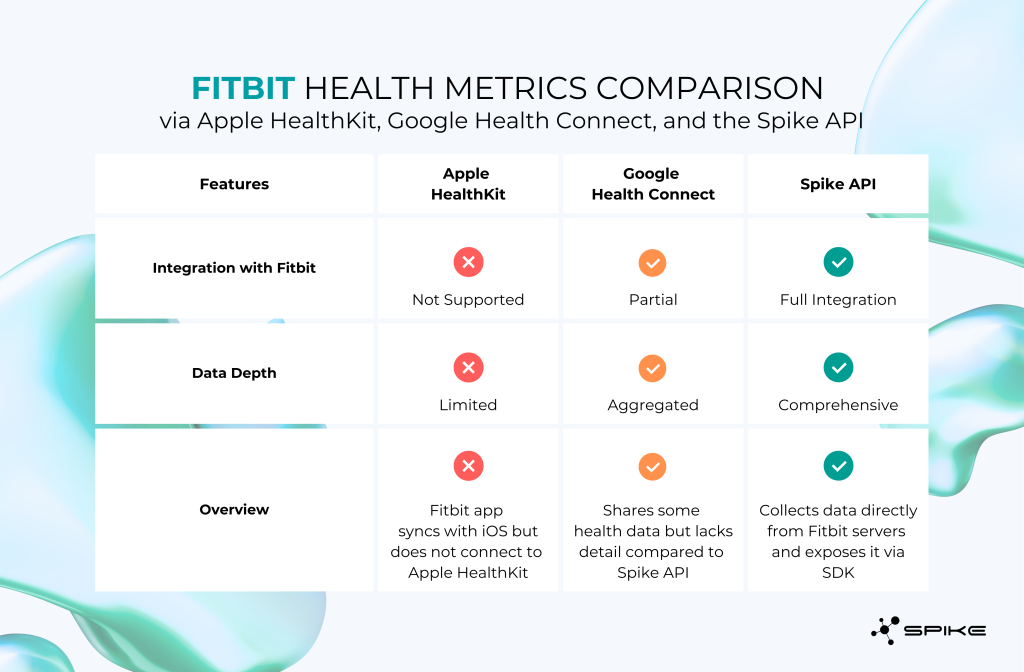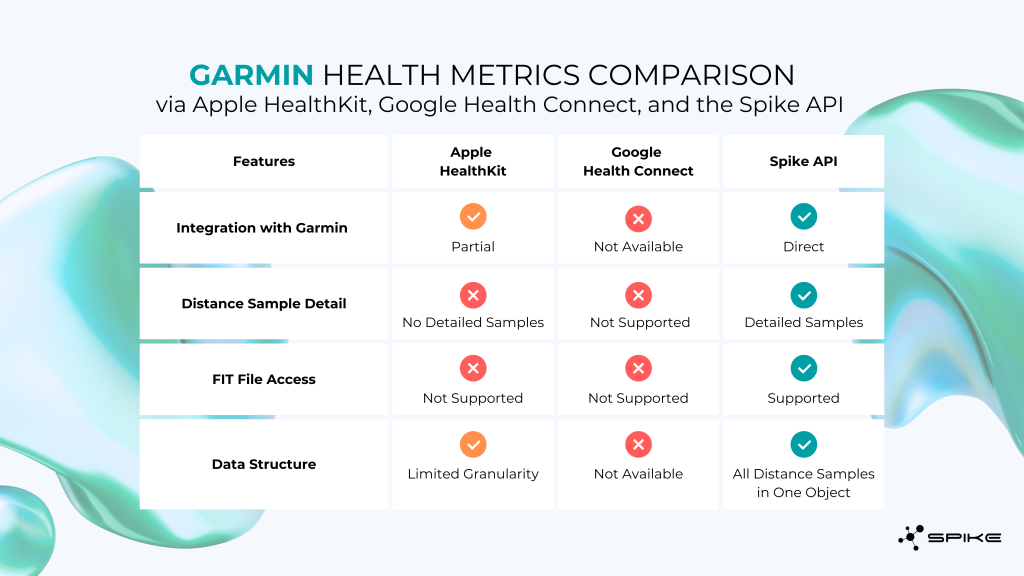Author

Full name
Job title, Company name

Spike API addresses these challenges head-on, offering a developer-first, provider-focused approach that simplifies integration while improving data fidelity and utility. Here’s why Spike API stands out as the smarter, more powerful alternative for developers building with health data.
Advantage: No need to write and maintain separate logic for each aggregator’s model.
One of the biggest challenges developers face with HealthKit and Health Connect is the fragmented nature of their data models. Each aggregator has its own structure, naming conventions, and coverage areas.
Spike API eliminates this complexity by offering a consolidated, unified data model. Regardless of the source – be it Garmin, Oura, Polar, Fitbit, or other providers – Spike API normalizes data into a single, consistent schema. This simplifies integration efforts, reduces the chance for data discrepancies, and speeds up development cycles.
Advantage: Broader and more consistent access to health data from top providers.
Apple HealthKit and Google Health Connect depend on individual vendors’ willingness to integrate with them – which isn’t always the case. For example:
Spike API, on the other hand, connects directly to provider APIs, enabling a far wider and more reliable data pipeline. This approach ensures developers get comprehensive coverage from major health and fitness ecosystems without relying on limited aggregator support.

Advantage: Fewer API calls, better performance, and easier data handling.
Unlike traditional aggregators that return raw, unorganized values, Spike API provides multiple data endpoints to retrieve related data in one response.
As a result, developers can retrieve precisely the data they need, in the format that best supports their application.
Advantage: Get the full picture, not just the fragments available via aggregators.
Data submitted to Apple HealthKit or Google Health Connect is often limited in scope or lacks important data. For instance, providers may omit the activity type, or fail to specify whether data was recorded manually or via a device.
Spike’s backend connects directly to provider APIs, allowing access to a fuller set of metrics, ensuring greater reliability and detail in every record.
Advantage: Access to workout details not available through traditional aggregators.
While FIT files are commonly used to store complete workout datasets – especially in the endurance sports world – neither Apple HealthKit nor Google Health Connect provides them.
Spike API supports ingestion of FIT files, unlocking data like GPS traces, running cadence, and more.

Advantage: Build responsive, low-latency features like live dashboards or health alerts.
Spike API supports event-driven webhook notifications – allowing your backend to receive updates the moment new data is available. This level of responsiveness is not possible with HealthKit or Health Connect, where data access is confined to the application layer and must be polled.
Advantage: Enterprise-grade data management & privacy-first design.
Spike’s backend architecture prioritizes security, privacy, and compliance from day one:
While Apple HealthKit and Google Health Connect play an important role in the health data ecosystem, and were designed to promote open data sharing, in practice, they lack the depth, consistency, and reliability developers require. Spike API fills that gap – delivering richer data, broader provider access, a unified model, and event-driven webhook notifications in a secure and flexible package.
Whether you’re building a fitness tracker, wellness app, or a clinical dashboard, Spike API gives you the foundation you need to scale fast and deliver accurate, reliable user insights.
Spike API offers a unified data model and connects directly to provider APIs (like Garmin and Fitbit), unlike Apple HealthKit and Google Health Connect which rely on limited, fragmented aggregator frameworks.
No. Spike API normalizes data into a single, consolidated schema – eliminating the need to write separate logic for each source like Apple HealthKit or Google Health Connect.
Spike API integrates directly with all major providers including Garmin, Fitbit, Huawei, and others – offering broader, more reliable data access than Apple HealthKit or Google Health Connect can provide.
Spike retrieves data directly from provider APIs, which often includes richer data (like activity type, device source, timestamps) that aggregators typically omit.
Yes. Spike can ingest FIT files, providing access to high-resolution data that Apple HealthKit and Google Health Connect don’t support.
Spike API offers webhook-based notifications, allowing your app to receive updates as soon as new data becomes available – enabling features like live dashboards and instant alerts.
Absolutely. Spike API is built with a privacy-first design, supporting data normalization, PII obfuscation, secure storage, and scalable policies for enterprise use.
Whether you’re building a fitness, digital health or wellness app, Spike API gives you the flexibility and data depth to scale fast and deliver accurate insights.